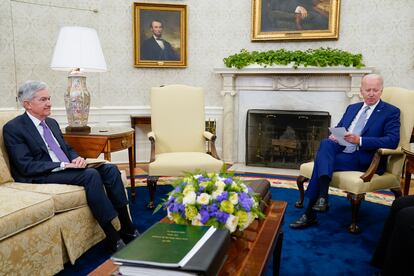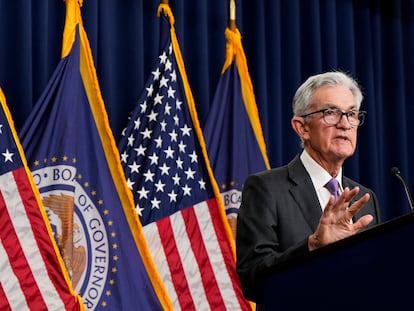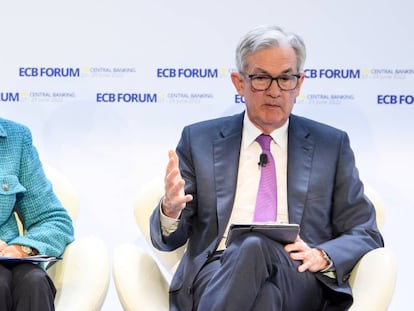The White House defends the Fed’s independence in the face of Trump’s threats
After allies of the ex-president produced a 10-page plan to weaken the central bank, the Council of Economic Advisers issued a statement warning of the dangers of political interference


The future of U.S. monetary policy also depends on the result of the presidential elections on November 5. During his presidency, Donald Trump showed little respect for the independence of the Federal Reserve and criticized its chair, Jerome Powell, who he himself appointed. President Joe Biden later confirmed Powell for a second term until 2026. Now, Trump has not only said that he will not support Powell for a new term, but advisors in his campaign orbit are considering more drastic proposals. In the face of these threats, the White House has come out in defense of the central bank’s independence through its Council of Economic Advisers (CEA).
A few days ago, the CEA published a post that could almost be seen as an academic article if it were not for its timing. “The Biden-Harris administration has consistently elevated the importance of an independent central bank. Given that this issue has come up in various settings, CEA thought this was a good moment to explain what central bank independence (CBI) is and why it is so important,” the note begins.
One of those “various settings” is Trump’s insistence on questioning Powell. When he was in the White House, Trump asked for rate cuts. Now, he has groundlessly argued that if Powell lowers rates (which is unlikely to happen in the short term), he would be doing so to help Biden’s re-election. In addition to Trump’s public comments, The Wall Street Journal revealed a few weeks ago that the former president’s allies were studying proposals that would erode the independence of the central bank and that they had listed these ideas in a 10-page summary document.
To begin with, although Powell’s term should be respected until its conclusion in 2026, the document argues that Trump could appoint a new chair of the Federal Reserve if he was elected president. According to this controversial thesis, Powell only needs to remain on the Fed’s board of governors.
The group working on the proposals is made up of former Trump administration officials and other allies of the former president, but does not play a formal role in his campaign. In addition to proposing that Powell could be cast out before his term ends, the document contends that Trump should be consulted on decisions on interest rates and recommends subjecting the regulations to be approved by the Federal Reserve to the review of the White House and the Treasury. This could affect the financial sector.
Biden has made it clear that he respects the independence of the central bank, even though both inflation and high interest rates have eroded his popularity. In a May 2022 article in The Wall Street Journal, he wrote: “My predecessor demeaned the Fed, and past presidents have sought to influence its decisions inappropriately during periods of elevated inflation. I won’t do this.” And then he delivered that same message to Powell in person. Current Treasury Secretary Janet Yellen was Powell’s predecessor as Fed chair, and National Economic Council Chair Lael Brainard was vice chair.
In its recent release, the White House insists that a central bank’s ability to conduct monetary policy without political interference is a critical component of its ability to control inflation, citing research, theory and history. This is the case in almost all advanced economies and many developing countries. In the United States, Congress formally established the Federal Reserve’s dual mandate of ensuring full employment and price stability and took steps to insulate it from political interference through the Federal Reserve Reform Act of 1977.
The CEA notes that when credibility is undermined by political influence, individuals, companies and other price-setters are less likely to believe in the central bank’s commitment to reducing inflation, which in turn can induce higher inflation. It cites former Federal Reserve chair, Ben Bernanke, who argued: “A central bank subject to short-term political influences would likely not be credible when it promised low inflation, as the public would recognize the risk that monetary policymakers could be pressured to pursue short-run expansionary policies that would be inconsistent with long-run price stability.”
The White House looks at historical examples of how a non-independent central bank can be put under political pressure to cut rates. It recalls that Richard Nixon pressured then-Federal Reserve chair Arthur Burns to engineer a favorable economy in time for the 1972 presidential election. And before that, the tensions between president Harry Truman and the central bank after World War II, when the Fed raised rates to contain inflation.
“We in the Biden administration are highly motivated by this history and will continue our unwavering support for CBI. History could not be clearer regarding the lasting and damaging inflationary consequences of ignoring this lesson or reversing the hard-earned progress of the past half century,” it ends, without directly mentioning the proposals from Trump’s allies.
Powell ignores pressure
Powell himself has insisted on the importance of overseeing U.S. monetary policy without political pressures. “In the case of the Federal Reserve, independence is essential to our ability to serve the public,” he said at an event at Stanford University last month. “Fed policymakers serve long terms that are not synchronized with election cycles. Our decisions are not subject to reversal by other parts of the government, other than through legislation. This independence both enables and requires us to make our monetary policy decisions without consideration of short-term political matters,” he added.
Interest rates in the U.S. range between 5.25%-5.5%, the highest figure in more than 23 years. Until a few months ago, it looked as if the central bank would start lowering interest rates in the months leading up to the elections, but poor inflation data in the first quarter have delayed rate cuts. Investors are waiting for the Federal Open Market Committee (FOMC) to update their forecasts on June 12, but the market believes that only a 0.25-point cut is likely before the end of the year, instead of the 3-point cut that the Fed predicted in March.
At the May 1 press conference following the last FOMC meeting, Powell challenged anyone to find any political reference in the transcripts of the Federal Reserve meetings held near elections. “We’re always going to do what we think the right thing for the economy is when we come to that consensus view [...]. That’s our record. That’s what we do. We’re not looking at anything else. You know, it’s hard enough to get the economics right here. These are difficult things, and if we were to take on a whole, another, set of factors and use that as a new filter, it would reduce the likelihood we’d actually get the economics right. So that’s how we think about it around here. We’re at peace over it. We know that we’ll do what we think is the right thing,” he said.
Sign up for our weekly newsletter to get more English-language news coverage from EL PAÍS USA Edition
Tu suscripción se está usando en otro dispositivo
¿Quieres añadir otro usuario a tu suscripción?
Si continúas leyendo en este dispositivo, no se podrá leer en el otro.
FlechaTu suscripción se está usando en otro dispositivo y solo puedes acceder a EL PAÍS desde un dispositivo a la vez.
Si quieres compartir tu cuenta, cambia tu suscripción a la modalidad Premium, así podrás añadir otro usuario. Cada uno accederá con su propia cuenta de email, lo que os permitirá personalizar vuestra experiencia en EL PAÍS.
¿Tienes una suscripción de empresa? Accede aquí para contratar más cuentas.
En el caso de no saber quién está usando tu cuenta, te recomendamos cambiar tu contraseña aquí.
Si decides continuar compartiendo tu cuenta, este mensaje se mostrará en tu dispositivo y en el de la otra persona que está usando tu cuenta de forma indefinida, afectando a tu experiencia de lectura. Puedes consultar aquí los términos y condiciones de la suscripción digital.
More information
Archived In
Últimas noticias
Welcome to the post-religion era: The idea of Christianity as the absolute truth has become obsolete
‘I thought you would like it’: The risky sexual practice popularized by TV shows and TikTok
The digitalization of tourism: ‘They promise experiences and gave us the worst possible one’
Mexican peso defies uncertainty with forecasts of a new period of stability in 2026
Most viewed
- Sinaloa Cartel war is taking its toll on Los Chapitos
- Oona Chaplin: ‘I told James Cameron that I was living in a treehouse and starting a permaculture project with a friend’
- Reinhard Genzel, Nobel laureate in physics: ‘One-minute videos will never give you the truth’
- Why the price of coffee has skyrocketed: from Brazilian plantations to specialty coffee houses
- Silver prices are going crazy: This is what’s fueling the rally










































